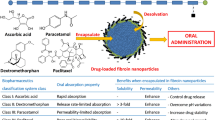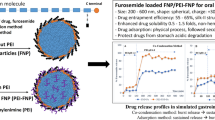Abstract
Concomitant intake of alcoholic beverages with sustained-release oral formulations may potentially lead to dose dumping. Alcohol-resistance testing is currently a requirement for the manufacturers by regulatory authorities. Silk fibroin produced by silkworm Bombyx mori is suggested in this work as a potential alternative to a narrow spectrum of alcohol-resistant excipients. Oxycodone HCl, tramadol HCl, and flurbiprofen were selected as model drugs and formulated with regenerated silk fibroin either in the form of an amorphous solid dispersion or as a physical mixture and compressed into tablets. Preliminary compactability and tampering-resistance studies were performed. The ethanol-resistance was tested in media containing 5%, 10%, 20%, or 40% (v/v) ethanol concentration. Drug release profiles were compared using f2 similarity factor. Good mechanical tampering-resistance (tensile strength of 14.6 MPa at 400 MPa compression pressure) was obtained for tablets compressed from physical mixture. Tablets compressed from amorphous solid dispersion had lower tensile strength (2.2 MPa) but showed chemical tampering-resistance to extraction by pure ethanol (7.1% of oxycodone HCl after 24 h). Drug release is controlled predominantly by swelling and diffusion. With an increasing ethanol concentration in release medium, the tablets swelled less, resulting in a slower release. This trend was similar for all tested drugs and for both physical states formulations. No dose dumping occurred in the presence of ethanol; therefore, silk fibroin could be considered as an alternative alcohol-resistant excipient for sustained release application.









Similar content being viewed by others
References
Siepmann J, Siepmann F, Swarbrick J. Time-controlled drug delivery systems. Mod Pharm. 2009;2:1–22.
Meyer RJ, Hussain AS. FDA’s ACPS meeting, October 2005 awareness topic: mitigating the risks of ethanol induced dose dumping from oral sustained/controlled release dosage forms. [cited 2018 Jun 20]. Available from: http://citeseerx.ist.psu.edu/viewdoc/download?doi=10.1.1.534.5704&rep=rep1&type=pdf.
Friebe TP, Hughes K, Hebestreit J-P, Rosiaux Y, Yunis M. Regulatory considerations for alcohol-induced dose dumping of oral modified-release formulations. Pharm Technol Eur. 2015;27:20–6 [cited 2018 Jun 20]. Available from: http://www.pharmtech.com/regulatory-considerations-alcohol-induced-dose-dumping-oral-modified-release-formulations.
Lennernäs H. Ethanol-drug absorption interaction: potential for a significant effect on the plasma pharmacokinetics of ethanol vulnerable formulations. Mol Pharm. 2009;6:1429–40 [cited 2018 Jun 20]. Available from: http://www.ncbi.nlm.nih.gov/pubmed/19655809.
Walden M, Nicholls FA, Smith KJ, Tucker GT. The effect of ethanol on the release of opioids from oral prolonged-release preparations. Drug Dev Ind Pharm. 2007;33:1101–11 [cited 2018 Jun 18]. Available from: http://www.tandfonline.com/doi/full/10.1080/03639040701377292.
Traynor MJ, Brown MB, Pannala A, Beck P, Martin GP. Influence of alcohol on the release of tramadol from 24-h controlled-release formulations during in vitro dissolution experiments. Drug Dev Ind Pharm. 2008;34:885–9 [cited 2018 Jun 18]. Available from: http://www.tandfonline.com/doi/full/10.1080/03639040801929240.
Kreek MJ. Opioid interactions with alcohol. Adv Alcohol Subst Abuse. 1984;3:35–46 [cited 2018 Oct 30]. Available from: http://www.tandfonline.com/doi/abs/10.1300/J251v03n04_04.
Mastropietro DJ, Omidian H. Current approaches in tamper-resistant and abuse-deterrent formulations. Drug Dev Ind Pharm. 2013;39:611–24 [cited 2018 Jun 27]. Available from: http://www.tandfonline.com/doi/full/10.3109/03639045.2012.680468.
Herz A. Endogenous opioid systems and alcohol addiction. Psychopharmacology (Berl). 1997;129:99–111 [cited 2018 Oct 30]. Available from: http://link.springer.com/10.1007/s002130050169.
Jedinger N, Khinast J, Roblegg E. The design of controlled-release formulations resistant to alcohol-induced dose dumping – a review. Eur J Pharm Biopharm. 2014;87:217–26 [cited 2018 Jun 18]. Available from: https://www.sciencedirect.com/science/article/pii/S0939641114000666.
Avachat AM, Nandare DS. Effect of alcohol on drug release kinetics from HPMC-based matrix tablets using model drugs. Dissolution Technol. 2014;21:11–7 [cited 2018 Jun 18]. Available from: https://pdfs.semanticscholar.org/d850/d73ef2dec30d2d512c0fe857d0957029c719.pdf.
Roberts M, Cespi M, Ford JL, Dyas AM, Downing J, Martini LG, et al. Influence of ethanol on aspirin release from hypromellose matrices. Int J Pharm. 2007;332:31–7 [cited 2018 Jun 20]. Available from: https://www.sciencedirect.com/science/article/pii/S0378517306007903.
Yucel T, Lovett ML, Kaplan DL. Silk-based biomaterials for sustained drug delivery. J Control Release. 2014;190:381–97 [cited 2018 Jun 18]. Available from: https://www.sciencedirect.com/science/article/pii/S016836591400385X.
Kundu B, Rajkhowa R, Kundu SC, Wang X. Silk fibroin biomaterials for tissue regenerations. Adv Drug Deliv Rev. 2013;65:457–70. https://doi.org/10.1016/j.addr.2012.09.043.
Wenk E, Merkle HP, Meinel L. Silk fibroin as a vehicle for drug delivery applications. J Control Release. 2011;150:128–41. https://doi.org/10.1016/j.jconrel.2010.11.007.
Rockwood DN, Preda RC, Yücel T, Wang X, Lovett ML, Kaplan DL. Materials fabrication from Bombyx mori silk fibroin. Nat Protoc. 2011;6:1612–31 [cited 2018 Jun 19]. Available from: http://www.nature.com/doifinder/10.1038/nprot.2011.379.
Jin HJ, Kaplan DL. Mechanism of silk processing in insects and spiders. Nature. 2003;424:1057–61.
Heim M, Keerl D, Scheibel T. Spider silk: from soluble protein to extraordinary fiber. Angew Chem Int Ed. 2009;48:3584–96 [cited 2018 Jun 18]. Available from: http://doi.wiley.com/10.1002/anie.200803341.
Nam J, Park YH. Morphology of regenerated silk fibroin: effects of freezing temperature; alcohol addition, and molecular weight. J Appl Polym Sci. 2001;81:3008–21 [cited 2018 Jun 18]. Available from: http://doi.wiley.com/10.1002/app.1751.
Li M, Lu S, Wu Z, Yan H, Mo J, Wang L. Study on porous silk fibroin materials. I. Fine structure of freeze dried silk fibroin. J Appl Polym Sci. 2001;79:2185–91 [cited 2018 Jun 18]. Available from: http://doi.wiley.com/10.1002/1097-4628%2820010321%2979%3A12%3C2185%3A%3AAID-APP1026%3E3.0.CO%3B2-3.
Shen Y, Johnson MA, Martin DC. Microstructural characterization of Bombyx mori silk fibers. Macromolecules. 1998;31:8857–64 [cited 2018 Jun 18]. Available from: http://pubs.acs.org/doi/abs/10.1021/ma980281j.
Ling S, Qi Z, Knight DP, Shao Z, Chen X. Synchrotron FTIR microspectroscopy of single natural silk fibers. Biomacromolecules. 2011;12:3344–9 [cited 2018 Jun 18]. Available from: https://pubs.acs.org/doi/pdf/10.1021/bm2006032.
Bartholomaeus JH, Arkenau-Marić E, Galia E. Opioid extended-release tablets with improved tamper-resistant properties. Expert Opin Drug Deliv. 2012;9:879–91 [cited 2018 Jun 19]. Available from: http://www.tandfonline.com/doi/full/10.1517/17425247.2012.698606.
Fell JT, Newton JM. Determination of tablet strength by the diametral compression test. J Pharm Sci. 1970;59:688–91 [cited 2018 Jun 18]. Available from: http://onlinelibrary.wiley.com/doi/10.1002/jps.2600590523/full.
D’Souza S, Mayock S, Salt A. A review of in vivo and in vitro aspects of alcohol-induced dose dumping. AAPS Open. 2017;3:5 [cited 2018 Jun 26]. Available from: http://aapsopen.springeropen.com/articles/10.1186/s41120-017-0014-9.
Levitt MD, Li R, DeMaster EG, Elson M, Furne J, Levitt DG. Use of measurements of ethanol absorption from stomach and intestine to assess human ethanol metabolism. Am J Phys. 1997;273:G951–7 [cited 2018 Jun 18]. Available from: http://www.physiology.org/doi/10.1152/ajpgi.1997.273.4.G951.
Moore JW, Planner HH. Mathematical comparison of dissolution profiles. Pharm Technol. 1996;20:64–74 [cited 2018 Aug 1]. Available from: https://ci.nii.ac.jp/naid/10014530983/.
Li M, Ogiso M, Minoura N. Enzymatic degradation behavior of porous silk fibroin sheets. Biomaterials. 2003;24:357–65 [cited 2018 Jun 19]. Available from: https://www.sciencedirect.com/science/article/pii/S0142961202003265.
Liu B, Song Y, Jin L, Wang Z, Pu D, Lin S, et al. Silk structure and degradation. Colloids Surf B Biointerfaces. 2015;131:122–8 [cited 2018 Jun 19]. Available from: https://www.sciencedirect.com/science/article/pii/S0927776515002593.
Arai T, Freddi G, Innocenti R, Tsukada M. Biodegradation of Bombyx mori silk fibroin fibers and films. J Appl Polym Sci. 2004;91:2383–90 [cited 2018 Jun 19]. Available from: http://doi.wiley.com/10.1002/app.13393.
Katayama H, Issiki M, Yoshitomi H. Application of fibroin in controlled release tablets containing theophylline. Biol Pharm Bull. 2000;23:1229–34 [cited 2018 Jun 19]. Available from: http://pdf.lookchem.com/pdf/22/e72e0e3f-a478-42b7-acf1-fb86506de024.pdf.
Hines DJ, Kaplan DL. Mechanisms of controlled release from silk fibroin films. Biomacromolecules. 2011;12:804–12 [cited 2019 Mar 23]. Available from: http://www.ncbi.nlm.nih.gov/pubmed/21250666.
Schneider JP, Matthews M, Jamison RN. Abuse-deterrent and tamper-resistant opioid formulations. CNS Drugs. 2010;24:805–10 [cited 2018 Jun 27]. Available from: http://link.springer.com/10.2165/11584260-000000000-00000.
Romach MK, Schoedel KA, Sellers EM. Update on tamper-resistant drug formulations. Drug Alcohol Depend. 2013;130:13–23 [cited 2018 Jun 27]. Available from: https://www.sciencedirect.com/science/article/pii/S0376871613000227.
Leece P, Orkin AM, Kahan M. Tamper-resistant drugs cannot solve the opioid crisis. CMAJ. 2015;187:717–8 [cited 2018 Jun 27]. Available from: http://www.ncbi.nlm.nih.gov/pubmed/26124228.
Dashevskiy A, Bodmeier R, Fussnegger BD. Alcohol-induced dose dumping resistant matrix tablets with Kollidon ® SR. Poster Present AAPS Annu Meet 13–17112016, Denver. Poster presented at AAPS Annual Meeting, 13.-17.11.2016, Denver; 2016.
Lenaerts V, Moussa I, Dumoulin Y, Mebsout F, Chouinard F, Szabo P, et al. Cross-linked high amylose starch for controlled release of drugs: recent advances. J Control Release. 1998;53:225–34 [cited 2018 Jun 18]. Available from: https://www.sciencedirect.com/science/article/pii/S0168365997002563.
Ravenelle F, Rahmouni M. Contramid®: high-amylose starch for controlled drug delivery. 2006 [cited 2018 Jun 18]. p. 79–104. Available from: http://pubs.acs.org/doi/abs/10.1021/bk-2006-0934.ch004.
Lin Y, Xia X, Shang K, Elia R, Huang W, Cebe P, et al. Tuning chemical and physical cross-links in silk electrogels for morphological analysis and mechanical reinforcement. Biomacromolecules. 2013;14:2629–35 [cited 2018 Jun 18]. Available from: http://pubs.acs.org/doi/10.1021/bm4004892.
Kawahara Y, Shioya M, Takaku A. Influence of swelling of noncrystalline regions in silk fibers on modification with methacrylamide. J Appl Polym Sci. 1996;59:51–6 [cited 2018 Jun 18]. Available from: https://onlinelibrary.wiley.com/doi/abs/10.1002/(SICI)1097-4628(19960103)59:1%3C51::AID-APP8%3E3.0.CO;2-L.
Holt S. Observations on the relation between alcohol absorption and the rate of gastric emptying. Can Med Assoc J. 1981;124:267–77 [cited 2019 Mar 15]. 297. Available from: http://www.ncbi.nlm.nih.gov/pubmed/7459787.
Cortot A, Jobin G, Ducrot F, Aymes C, Giraudeaux V, Modigliani R. Gastric emptying and gastrointestinal absorption of alcohol ingested with a meal. Dig Dis Sci. 1986;31:343–8 [cited 2019 Mar 15]. Available from: http://www.ncbi.nlm.nih.gov/pubmed/3956329.
Altman GH, Diaz F, Jakuba C, Calabro T, Horan RL, Chen J, et al. Silk-based biomaterials. Biomaterials. 2003;24:401–16 [cited 2018 Aug 1]. Available from: https://www.sciencedirect.com/science/article/pii/S0142961202003538.
Chen J, Wang Q, Hua Z, Du G. Research and application of biotechnology in textile industries in China. Enzyme Microb Technol [Internet]. 2007 [cited 2018 Aug 1];40:1651–5. Available from: https://ac.els-cdn.com/S0141022906004029/1-s2.0-S0141022906004029-main.pdf?_tid=c892c8cc-97f8-4f61-8247-4ced2d8d3dda&acdnat=1533128511_d1623a89facac39446565ec5e101c689
Lindman B, Karlström G, Stigsson L. On the mechanism of dissolution of cellulose. J Mol Liq. 2010;156:76–81 [cited 2018 Aug 8]. Available from: https://www.sciencedirect.com/science/article/pii/S0167732210001327.
Medronho B, Lindman B. Brief overview on cellulose dissolution/regeneration interactions and mechanisms. Adv Colloid Interf Sci. 2015;222:502–8 [cited 2018 Aug 8]. Available from: https://www.sciencedirect.com/science/article/pii/S0001868614001924.
Peng H, Dai G, Wang S, Xu H. The evolution behavior and dissolution mechanism of cellulose in aqueous solvent. J Mol Liq. 2017;241:959–66 [cited 2018 Aug 8]. Available from: https://www.sciencedirect.com/science/article/pii/S0167732217316367.
Funding
This study was partially supported by the Charles University Grant Agency, project GA UK No. 850617/2017 and the Funding Agency of Charles University under Grant No. SVV 260 4
Author information
Authors and Affiliations
Corresponding author
Additional information
Publisher’s Note
Springer Nature remains neutral with regard to jurisdictional claims in published maps and institutional affiliations.
Electronic supplementary material
ESM 1
(DOCX 2309 kb)
Rights and permissions
About this article
Cite this article
Kozak, J., Rabiskova, M. & Lamprecht, A. Silk Fibroin as a Novel Alcohol-Resistant Excipient for Sustained-Release Tablet Formulation. AAPS PharmSciTech 20, 279 (2019). https://doi.org/10.1208/s12249-019-1494-9
Received:
Accepted:
Published:
DOI: https://doi.org/10.1208/s12249-019-1494-9




